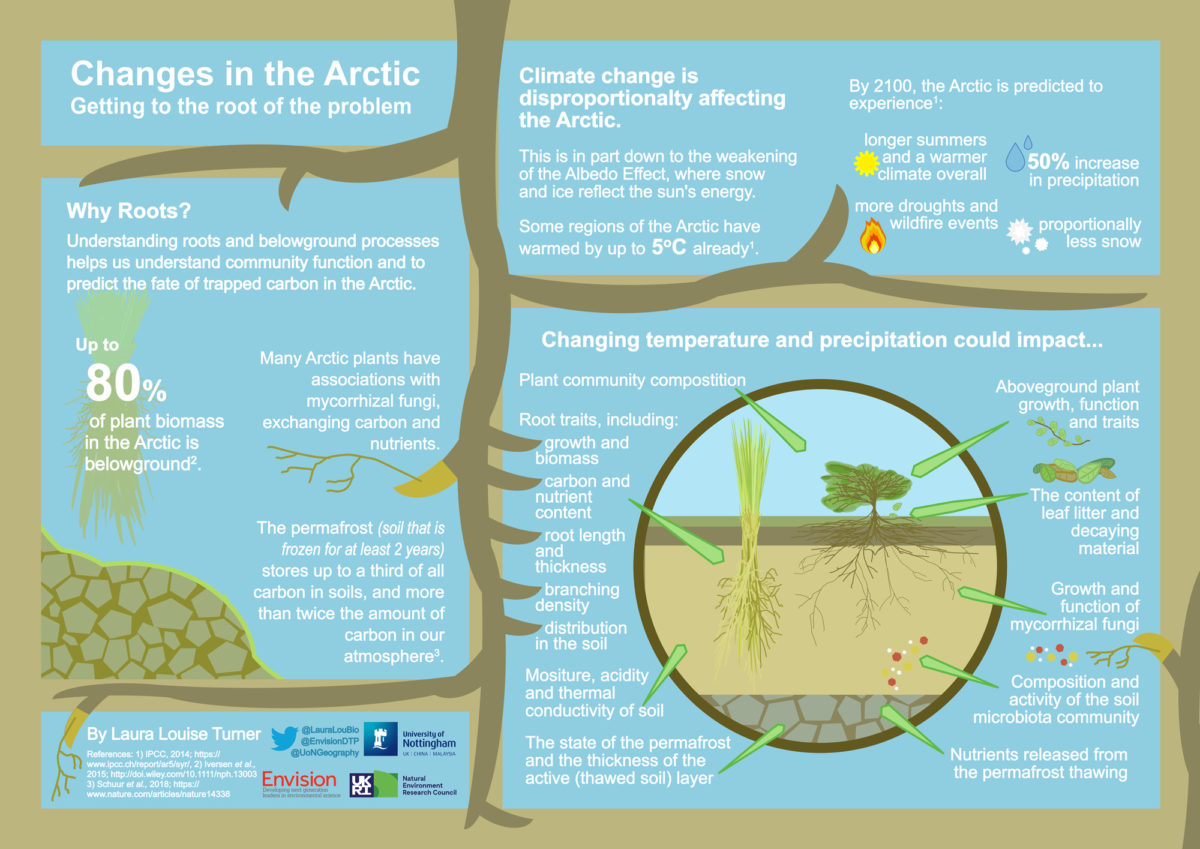Summary
This infographic describes climate change in the Arctic, some potential impacts on ecosystem functioning, specifically roots and belowground processes. It highlights the importance of studying belowground components of these Arctic ecosystems. For non-specific academic audience.
Transcript
Climate change is occurring in the Arctic at a rapid rate compared with the rest of the globe. This is due to the Albedo Effect, where the sun’s energy is reflected away from the environment by snow and ice. Where glaciers, ice and snow melt to reveal bare ground or open ocean, the sun’s energy is absorbed and radiates as heat.
The Arctic has experienced significant warming and climate change already, including average temperature increases of up to 5°C in some regions. The Arctic is predicted to continue to warm at a rapid pace, and increased precipitation, with increasing percentage of precipitation falling as rain rather than snow1. Other impacts of climate change, including increased winter warming and extreme warming events, droughts, frost drought, pest outbreaks, may also increase.
The responses of plant roots and other components of the belowground ecosystem are important pieces of the puzzle to determine the impacts of climate change in the Arctic.
The majority of plant material (or biomass) is belowground in Arctic ecosystems2, and plant roots play key roles in influencing their environment. Interactions between roots and other organisms, including the mycorrhizal fungi many plants associate with, are essential for ecosystem functioning.
Furthermore, the soils of the Arctic, especially permanently frozen permafrost soils, are significant players in regulating the global carbon store. It is important that we maintain stores of carbon and reduce the release of carbon as greenhouse gases carbon dioxide, CO2, or methane, CH4, into the atmosphere. Soils in the northern latitudes store huge amounts of carbon, up to twice all the carbon found in our atmosphere3.
Environment changes can cause many impacts on Arctic ecosystems, including aboveground changes and shifts in community composition4. There are many belowground changes which are less well understood2. This could include changes to root traits, soil characteristics, the community and function of soil microbiota and permafrost dynamics. These interrelated changes are difficult to predict, as many environmental changes cause different impacts.
By understanding the impacts of environmental change of belowground ecosystem structure and function, we may gain better insight into future climate change impacts.
References
1) IPCC, 2014; https://www.ipcc.ch/report/ar5/syr/
2) Iversen et al., 2015; http://doi.wiley.com/10.1111/nph.13003
3) Schur et al., 2018; https://www.nature.com/articles/nature14338
4) Bjorkman et al., 2018; https://www.nature.com/articles/s41586-018-0563-7
Laura L. Turner
Laura is a PhD student at University of Nottingham studying the impacts of environmental change on roots and below ground processes in the Arctic
Email: Laura.turner@nottingham.ac.uk
Twitter: @lauraloubio
Organisation: University of Nottingham

